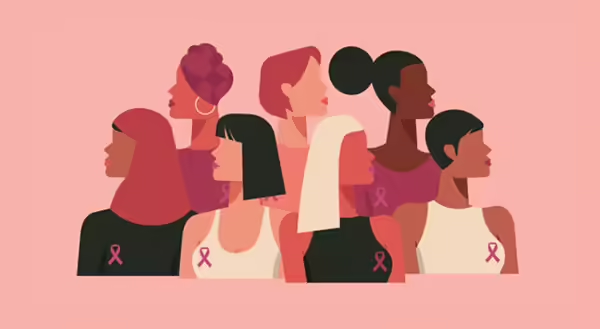
October is Breast Cancer Awareness Month.
Breast cancer is the most common cancer diagnosed among women in the United States. It is also the second leading cause of death among all cancers in women. Are you or a loved one at risk of breast cancer? Let's learn about the symptoms, risks, screening recommendations, and prevention.
What is Breast Cancer?
Breast cancer is a disease where cells grow at an unusually large pace in the breast's main three areas: lobules, ducts, and connective tissues. Lobules are the glands that produce milk, ducts are where milk is stored, and connective tissues are the surrounding area of the breast. Although breast cancer is most common among women, both men and women can develop the disease.
What Are the Signs to Look For?
It’s important to note that all bodies are different. There is no “normal” way breasts should look. Some women with breast cancer may experience signs and symptoms and others may not. However, these may be some warning signs:
- New lump in the breast or the underarm area
- Thickening or swelling in the breast area
- Irritation or dimpling of breast skin
- Redness or flaky skin
- Pain in the nipple area
- Pulling in of the nipple
- Nipple discharge
- Change in size or shape of the breast
- Pain in the breast area
These are not exclusive signs of breast cancer and may be signs of other diseases, or none at all. If you have concerns, please see your primary care doctor.
Risk Factors
Some non-modifiable factors have been found to increase the risk of breast cancer such as:
- Age: older age increases the risk as most cases are diagnosed after the age of 50
- Genes: certain genetic mutations increase the risk
- Reproductive history: starting menstruation before age 12 and/or experiencing menopause after the age of 55
- High breast density
- Medical history of breast cancer and other breast diseases
- Family history of breast cancer or ovarian cancer
- Previous exposure to radiation in the breast or chest area
How Can You Reduce Your Risk?
There are lifestyle changes you can adopt to decrease your risk! These include:
- Being physically active
- Maintaining a healthy weight
- Eating a balanced diet
- Limiting alcohol consumption
- Consulting your doctor of the increased risk of breast cancer if taking oral contraceptives or hormone replacement therapy
- Breastfeeding when possible
- Avoiding tobacco
Breast Cancer Screening
Breast cancer screening is the examination of the breast to prevent or detect the disease. There are several different screening methods. Currently, it is recommended that women between the ages of 50 to 74 with an average risk receive one mammogram every two years. Those younger than 50 are encouraged to speak to their doctor to know if earlier screening is recommended.
- Mammograms are the best way to detect breast cancer early. Through this screening, x-rays are taken of the breast in a medical setting. This screening may cause some discomfort as it involves pressing of the breasts, but it is temporary, and screening is beneficial for detection.
- Breast magnetic resonance imaging (MRI) is another screening method encouraged for those with high risk for breast cancer. Magnets and radio waves are used to take images of the breast to detect irregularities.
- A clinical breast exam is a screening performed by a medical professional using their hands to feel for lumps or other changes in the breast.
- A breast self-exam is a screening done by yourself to search for any signs or changes in the breasts. This includes feeling for lumps, noticing pain or discharge, or any other changes in the breast that are a concern.
Remember that early detection through screening is important for early treatment and better health outcomes! Talk to your primary care doctor if you notice any signs or concerns.
How is Illinois Doing?
Unfortunately, there are factors out of people’s control that affect their health. These factors include access to healthcare, income, the physical environment, and society. On average, Illinois has a breast cancer new case rate of 132 diagnoses per 100,000 persons, but some counties in the state have much higher rates than the state average. Some of these counties include Warren, Scott, Ford, Greene, and Mercer.
Racial groups are also affected differently by breast cancer in Illinois. In fact, Black women in Illinois suffer from higher death rates from breast cancer despite having similar new case rates to White women. Nationally, breast cancer is the leading cause of cancer death among Hispanic women. Health resources, breast cancer education, and community outreach to populations in the state affected by breast cancer may be a good start to reducing the unequal burden of the disease.
Summary
With breast cancer being the most common cancer and the second leading cause of death among women, it is important to know the warning signs and risk factors. Adopting healthy lifestyle changes, seeking screening, and being aware of your personal risk may help secure a healthier life.
Resources
About the Author
Monserrat Carrillo-Rodriguez is a social and community health specialist. The Integrated Health Disparities program tackles health issues with an integrated lens of physical, mental, and community health providing programs and resources to address health inequities. She has experience working with diverse audiences both in Chicago and Champaign focused on disease prevention and health education. Monserrat is a two-time graduate of the University of Illinois, earning a bachelor’s degree in community health in 2020 and a master’s degree in public health in 2021. She works to reduce the burden of health disparities among vulnerable populations through evidence-based health behavior interventions and health education.